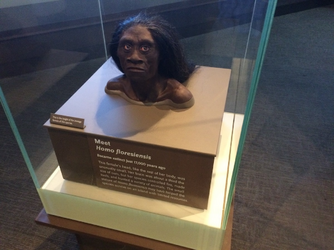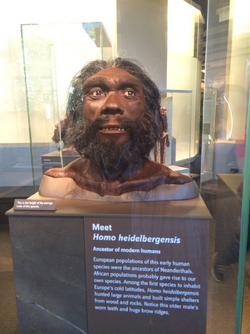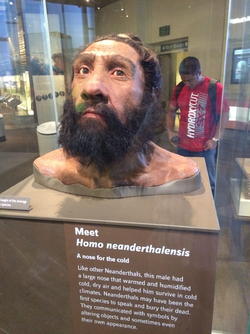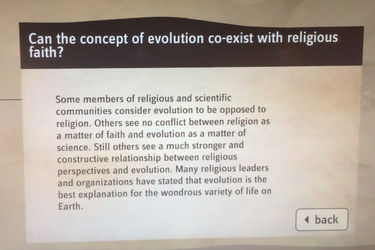(Article) (Archive)

This summer, I revisited the Smithsonian Institution’s National Museum of Natural History (NMNH), arguably the top science museum in the United States. Boasting more annual visitors than any other American museum, it’s called the “National Museum” not only because we all pay for it with our tax dollars but because its perspective represents the nation’s voice. That includes your own voice. While addressing other subjects, NMNH is in effect the country’s leading educator about a profound question: how animal complexity arose and how humans achieved their exceptional place in nature.
What is a human being, after all, as indicated by our biological origins? Are we chance debris cast up by unguided evolutionary processes or, perhaps, an intentional product revealing a designer’s care and purpose? Now more than ever, when the culture is worryingly confused about the nature and dignity of a man or woman, it matters how the NMNH is educating Americans.
How is it doing in this influential role? Does it continue to merit our trust? John West recently commented on how the Smithsonian retains a shocking off-site collection of stolen human brains — reflecting the museum’s racist past as it sought to document evolution (see here and here, a subject further explored in the award-winning YouTube documentary Human Zoos). But those, at least, are not on view to the public. What about the current on-site displays? As we’ll see, at the museum you will find a thoroughly evolutionary presentation of the scientific evidence, including many claims that are scientifically inaccurate.
Below I offer a visitor’s guide to the NMNH. But first, some vital statistics:
Inaccessible to the public on this floor, however, is something more sinister — a large section of staff scientist offices, including an office once used by Dr. Richard Sternberg. Sternberg was a research scientist at the Smithsonian until he was harassed and ultimately ousted for allowing the publication of a pro-intelligent design paper by Stephen Meyer in the peer-reviewed Proceedings of the Biological Society of Washington, in 2004. Sternberg is now a Senior Fellow with Discovery Institute and continues to do research on ID. For details, see his website.
Questions to Ponder: If you were an ID-friendly scientist working here, would you feel free to openly discuss hard questions about evolution with your colleagues, or would you feel pressured to stay silent? What are the implications for the ability of science to seek and discover the truth?

Some examples:



Questions to Ponder: Which of the species in the Hall of Human Origins deserve to be called “human”? Do you see any recognition of differences between humans and other species? Is there any recognition that human-like fossils appear abruptly in the hominid fossil record? If not, why do you think this is the case?
Questions to Ponder: Do you see any acknowledgment of the repeated pattern of abrupt appearance of different species in the history of life, such as the Cambrian explosion? If not, why not?
Questions to Ponder: Mosasaurs are another example of the many types of animals that explode onto the scene in the fossil record abruptly.14 What is the best explanation for this phenomenon — unguided evolution or intelligent design? Is this question explored in the exhibit? If not, why do you think that is?
Questions to Ponder: This exhibit is quick to highlight “legs” on the skeletons of ancient whales, suggesting they show that whales evolved from land-based mammalian ancestors. Yet even modern whales have “hip-like” bones that are not useless but have a reproductive function.15 How strong is the evidence for whale evolution? Cetaceans have many special features that allow them to live a fully marine aquatic lifestyle. Given their long generation times and low population sizes, could unguided evolutionary mechanisms convert a land-mammal to a whale in under 10 million years? ID theorists argue that the answer is no.16
Questions to Ponder: How different is a caterpillar from a butterfly? Can a process like unguided evolution program a caterpillar to metamorphose into a fully functional butterfly? The process must work entirely from the get-go or else metamorphosis will result in a dead organism. There are thus many obstacles to the evolution of such a complex feature.18
Questions to Ponder: When we consider amazing natural discoveries like gems or butterflies, do all arguments for design have to be scientific? Can beauty make a case for design?

Questions to Ponder: If evolution is not the “best explanation” for the complexity of life on Earth, then should we waste time trying to figure out how to make religion compatible with it?
Does the Smithsonian really respect religious views? In 2009, a Smithsonian-affiliated museum, the California Science Center (CSC), cancelled a contract from an ID-friendly group to rent a venue to premiere an ID documentary. They came after the Smithsonian’s chief spokesperson, Linda St. Thomas, was so upset about the CSC’s rental to a pro-ID group that she asked the Smithsonian’s director of affiliates, Harold Closter, to send a “cease and desist” letter to the CSC because of the Smithsonian “policy which is science and not religion”19:
Next time you’re in Washington, DC, I do recommend a visit to the National Museum of Natural History. But remember to take your scientific skepticism along with you, and perhaps a copy of this visitor’s guide. If the Smithsonian won’t even allow its affiliated museums to rent facilities to outside groups that are pro-intelligent design, if it intimidates pro-ID scientists, if it refuses to fully shed its racist past, if its exhibits are hopelessly biased, does objective science on biological origins have a chance at this prestigious, federally funded icon of science? Does this beloved national institution deserve our trust? It seems not.
(I'm not posting notes, they would add what is practically 5 more paragraphs to this already way too long articles)

This summer, I revisited the Smithsonian Institution’s National Museum of Natural History (NMNH), arguably the top science museum in the United States. Boasting more annual visitors than any other American museum, it’s called the “National Museum” not only because we all pay for it with our tax dollars but because its perspective represents the nation’s voice. That includes your own voice. While addressing other subjects, NMNH is in effect the country’s leading educator about a profound question: how animal complexity arose and how humans achieved their exceptional place in nature.
What is a human being, after all, as indicated by our biological origins? Are we chance debris cast up by unguided evolutionary processes or, perhaps, an intentional product revealing a designer’s care and purpose? Now more than ever, when the culture is worryingly confused about the nature and dignity of a man or woman, it matters how the NMNH is educating Americans.
How is it doing in this influential role? Does it continue to merit our trust? John West recently commented on how the Smithsonian retains a shocking off-site collection of stolen human brains — reflecting the museum’s racist past as it sought to document evolution (see here and here, a subject further explored in the award-winning YouTube documentary Human Zoos). But those, at least, are not on view to the public. What about the current on-site displays? As we’ll see, at the museum you will find a thoroughly evolutionary presentation of the scientific evidence, including many claims that are scientifically inaccurate.
Below I offer a visitor’s guide to the NMNH. But first, some vital statistics:
- NMNH was founded in Washington, DC, in 1846 and installed in its current neoclassical home in 1911.
- The facility is 1.5 million square feet, including 325,000 square feet devoted to public exhibits.
- Admission is free and it’s open every day but Christmas.
- There were 3.9 million visitors in 2022, over 10,000 per day.
- NMNH houses collections with over 146 million specimens of animal, vegetable, and mineral remains, stored in both public exhibits and scientific collections.
- It employs 185 staff scientists — but don’t expect any to publicly endorse intelligent design.
Ground Floor
The ground floor does not have any museum exhibits other than a Tyrannosaurus rex skull near the main entrance. It also has a café, store, and auditorium.Inaccessible to the public on this floor, however, is something more sinister — a large section of staff scientist offices, including an office once used by Dr. Richard Sternberg. Sternberg was a research scientist at the Smithsonian until he was harassed and ultimately ousted for allowing the publication of a pro-intelligent design paper by Stephen Meyer in the peer-reviewed Proceedings of the Biological Society of Washington, in 2004. Sternberg is now a Senior Fellow with Discovery Institute and continues to do research on ID. For details, see his website.
Questions to Ponder: If you were an ID-friendly scientist working here, would you feel free to openly discuss hard questions about evolution with your colleagues, or would you feel pressured to stay silent? What are the implications for the ability of science to seek and discover the truth?
First Floor
The first floor contains many of the museum’s exhibits devoted to biological history, including the David H. Koch Hall of Human Origins, the Kenneth E. Behring Family Hall of Mammals, the David H. Koch Hall of Fossils — Deep Time, a Sea Monsters exhibit, and the Sant Ocean Hall.David H. Koch Hall of Human Origins
This exhibit presents an unquestioned evolutionary view of human origins, declaring “we know humans evolved.” The exhibit undoubtedly has an agenda. Paleoanthropologist Dr. Rick Potts, who founded and directs the Human Origins Program at the Smithsonian, has stated he wants more public “acceptance” of evolution.1 That’s a strange word to use, especially when you consider that they present many claims that run counter to the scientific evidence.
Some examples:
- Claim: Humans are 98.8 percent genetically similar to chimpanzees, showing our common ancestry with chimps.
- Claim: Sahelanthropus tchadensis was an “early human” that walked “on two legs.”
- Claim: Australopithecines were “early humans” who also walked upright “on the ground” much like modern humans.
- Claim: Humans evolved slowly from apelike creatures, such as the australopithecines.
- Presentation: Hominid reconstructions humanize apes and ape-ify humans — Australopithecus africanusis presented as smiling and A. afarensis is portrayed intelligently gazing up at the sky.

- Presentation: Interestingly, as David Coppedge has observed at Evolution News, the depiction of human origins in this hall seems to possibly reflect the Smithsonian’s racist history even today, as the ascent from presumed pre-human ancestors is illustrated through the displays as an evolution toward looking more and more like white people.


- Claim: Unguided evolution is the “best explanation” for human origins.
Questions to Ponder: Which of the species in the Hall of Human Origins deserve to be called “human”? Do you see any recognition of differences between humans and other species? Is there any recognition that human-like fossils appear abruptly in the hominid fossil record? If not, why do you think this is the case?
- Claim: Mammalian fossil exhibits at the Smithsonian also claim that humans and all mammals descended from the “first mammal,” perhaps Morganucodon.
David H. Koch Hall of Fossils — Deep Time
Fossil-lovers will enjoy this world-class collection of specimens of dinosaurs, trilobites, mammals, plants, and other organisms. Unfortunately, everything is arranged and presented in a fully evolutionary context. Yet leading scientists acknowledge that the fossil record shows a pattern of abrupt appearance. That is, groups of organisms appear abruptly, without direct evolutionary precursors. Philosopher of science Stephen Meyer and paleontologist Günter Bechly document some 19 explosions in the history of life in their chapter, “The Fossil Record and Universal Common Ancestry,” in the volume Theistic Evolution (2017). Evolutionary anthropologist Jeffrey Schwartz remarks about the state of the evidence: “We are still in the dark about the origin of most major groups of organisms. They appear in the fossil record as Athena did from the head of Zeus — full-blown and raring to go, in contradiction to Darwin’s depiction of evolution as resulting from the gradual accumulation of countless infinitesimally minute variations.”13Questions to Ponder: Do you see any acknowledgment of the repeated pattern of abrupt appearance of different species in the history of life, such as the Cambrian explosion? If not, why not?
Sea Monsters Exhibit
Ancient giant marine animals are highlighted in this exhibit, including marine predators called mosasaurs which lived during the Cretaceous period.Questions to Ponder: Mosasaurs are another example of the many types of animals that explode onto the scene in the fossil record abruptly.14 What is the best explanation for this phenomenon — unguided evolution or intelligent design? Is this question explored in the exhibit? If not, why do you think that is?
Sant Ocean Hall
This exhibit takes you deep into the ocean where you will see fossils, skeletons, and preserved specimens of a Megalodon shark, whales, a giant squid, and other amazing creatures. One specimen is the coelacanth fish, a “living fossil” that was thought to have gone extinct over 60 million years ago but then was discovered living off the coast of Africa in the 1930s.Questions to Ponder: This exhibit is quick to highlight “legs” on the skeletons of ancient whales, suggesting they show that whales evolved from land-based mammalian ancestors. Yet even modern whales have “hip-like” bones that are not useless but have a reproductive function.15 How strong is the evidence for whale evolution? Cetaceans have many special features that allow them to live a fully marine aquatic lifestyle. Given their long generation times and low population sizes, could unguided evolutionary mechanisms convert a land-mammal to a whale in under 10 million years? ID theorists argue that the answer is no.16
Second Floor
The second floor contains the museum’s geological collections and some other biological collections, including the Janet Annenberg Hooker Hall of Geology, Gems, and Minerals, the Live Butterfly Pavilion and Live Insect Zoo, and the Hope Diamond.Janet Annenberg Hooker Hall of Geology, Gems, and Minerals
This exhibit offers incredible examples of exotic rocks that originated deep in the Earth, as well as beautiful specimens of meteorites — rocks from space. Some evolutionary scientists speculate that life arose on Earth due to panspermia, having been brought to our planet from space on meteorites, perhaps like the ones in this exhibit. However, panspermia has many problems — not the least of which is that it’s highly unlikely that life could survive the long trip through space and the re-entry process of colliding with the Earth. Moreover, the likelihood of life finding our solar system from another star system in space is infinitesimal.17Live Butterfly Pavilion and Live Insect Zoo
This exhibit is truly a special experience, as it allows you to walk through a climate-controlled exhibit filled with butterflies from the U.S., Mexico, Central and South America, Africa, India, China, and Southeast Asia, as well as tropical plants.Questions to Ponder: How different is a caterpillar from a butterfly? Can a process like unguided evolution program a caterpillar to metamorphose into a fully functional butterfly? The process must work entirely from the get-go or else metamorphosis will result in a dead organism. There are thus many obstacles to the evolution of such a complex feature.18
The Hope Diamond
This world-famous 45.52-carat (9.104 g) diamond has a fascinating history. It was mined in India in the 1600s, sold to King Louis XIV of France in 1668, but was then stolen from the French Crown Jewels in 1792 during the French Revolution, just a few months before Louis XVI was beheaded. Rumor held that it was worn by Marie Antoinette, and that there is a curse upon whoever owns the diamond. The gem reappeared in England several decades later, having been recut into its current shape and rebranded the “Hope Diamond.” It was then purchased and sold, and purchased and sold between various wealthy owners from the UK, U.S., and Turkey, until jeweler Harry Winston donated it to the Smithsonian in 1958.Questions to Ponder: When we consider amazing natural discoveries like gems or butterflies, do all arguments for design have to be scientific? Can beauty make a case for design?

Big Picture: The Smithsonian, Evolution, Intelligent Design, and Religion
The museum suggests that evolution and religion are compatible, noting that “Many religious leaders and organizations have stated that evolution is the best explanation for the wondrous variety of life on Earth.”Questions to Ponder: If evolution is not the “best explanation” for the complexity of life on Earth, then should we waste time trying to figure out how to make religion compatible with it?
Does the Smithsonian really respect religious views? In 2009, a Smithsonian-affiliated museum, the California Science Center (CSC), cancelled a contract from an ID-friendly group to rent a venue to premiere an ID documentary. They came after the Smithsonian’s chief spokesperson, Linda St. Thomas, was so upset about the CSC’s rental to a pro-ID group that she asked the Smithsonian’s director of affiliates, Harold Closter, to send a “cease and desist” letter to the CSC because of the Smithsonian “policy which is science and not religion”19:
Questions to Ponder: Of course, the Smithsonian was wrong to claim that ID is religion and not science — but their words speak volumes about how they act towards what they believe is “religion.” When the public is watching, the Smithsonian tries to put on a friendly face to religion. But do its actions speak louder than its words?This is one of our fears about affiliates. As you know, we cancelled an event about Intelligent Design (creationism) at MNH a couple years ago. It is against SI/MNH policy which is science and not religion. However, I have seen hundreds of twitters saying that SI is holding this premier, even though it is an affiliate in Calif. Can you tell them to cease and desist?
Next time you’re in Washington, DC, I do recommend a visit to the National Museum of Natural History. But remember to take your scientific skepticism along with you, and perhaps a copy of this visitor’s guide. If the Smithsonian won’t even allow its affiliated museums to rent facilities to outside groups that are pro-intelligent design, if it intimidates pro-ID scientists, if it refuses to fully shed its racist past, if its exhibits are hopelessly biased, does objective science on biological origins have a chance at this prestigious, federally funded icon of science? Does this beloved national institution deserve our trust? It seems not.
(I'm not posting notes, they would add what is practically 5 more paragraphs to this already way too long articles)